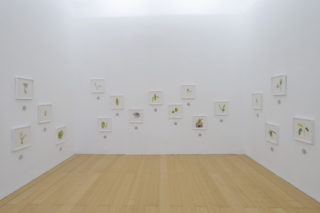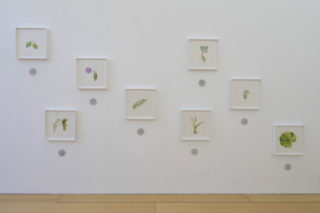
Decolonizing Botany / Jevy Jejapo-pyra Temitī-tyre 2020
watercolours, speakers, minimac
This installation benefits from the generous support of [N.A!] Project
Commissioned for ‘Rethinking Nature’
Courtesy of the artist and Alfonso Artiaco, Naples

Decolonizing Botany / Jevy Jejapo-pyra Temitī-tyre (detail) 2020
watercolours, speakers, minimac
This installation benefits from the generous support of [N.A!] Project
Commissioned for ‘Rethinking Nature’
Courtesy of the artist and Alfonso Artiaco, Naples
In her work, Maria Thereza Alves uncovers multiple cultural histories in South and Central America and addresses the relationship between knowledge forms, language, nature and community, thus affirming that 500 years of colonial domination have not erased the knowledge and resilience of different ecologies and peoples. Decolonizing Botany / Jevy Jejapo-pyra Temitī-tyre is an installation developed in collaboration with a group of Guarani people of the Jaguapiru Reservation in the Mato Grosso do Sul region of Brazil. Alves asked her long-time collaborator, teacher and local reservation leader Ke´y Rusú Katupyry, and his community to explain Guarani plant taxonomy. They present the nature and qualities of the 24 species in Guarani botany that Alves has recorded in her watercolours. Through this exercise emerges the complexity of Guarani thinking and its deeply relational nature, always weaving connections between living beings and their surroundings. What in the Latin botanical nomenclature is referred to as Nymphoides humboldtiana, in Guarani taxonomy is known as Yvoty mboporã pónhuregua, ‘five-sided flower of the spirit of the fields and forests: you will go away one day but I will not’. The project underlines the right to epistemic sovereignty of the Guarani people in showing how naming systems encode knowledge. Alves’ series of watercolours is presented alongside the honouring songs that community members performed for each plant in the work.
Artist statement
Colonization is a continuing process of theft of land, resources, bodies, beings and culture. The settler taking possession of, in this case, the Americas, requires renaming to consolidate the desired obliteration of the Indigenous. The use of European scientific nomenclature is part of this desire. Decolonizing Botany is an attempt to engage the visitor with the complexity of Guarani thought and the importance of relationality to other beings and the surroundings. There was a world, a respect, an honoring of earth and beings before the invasion and which continues into the present.
Ke´y Rusú Katupyry e Verá Poty Resakã – Artists’ statement
There has always been and still is – even with this destruction of forests, with mining, and with the expulsion of indigenous peoples from our lands – the respect of the Guarani and other indigenous peoples for everything in nature, even in our suffering, we continue our respect. The invasion destroys the vision and sounds, but not the memory of the Guarani people, that is still very strong and reawakens the dormant respect for everything from before the colonization / decolonization of the people. In respect, when we enter the forest, we first ask permission. In respect, we consider every plant a being that in the past was good, and its beauty enchants or heals people. The names of the plants come to us. We gather in the evening as a community and they tell us their names usually in song. So there is respect for everything – earth and life, for us, even for being a plant.